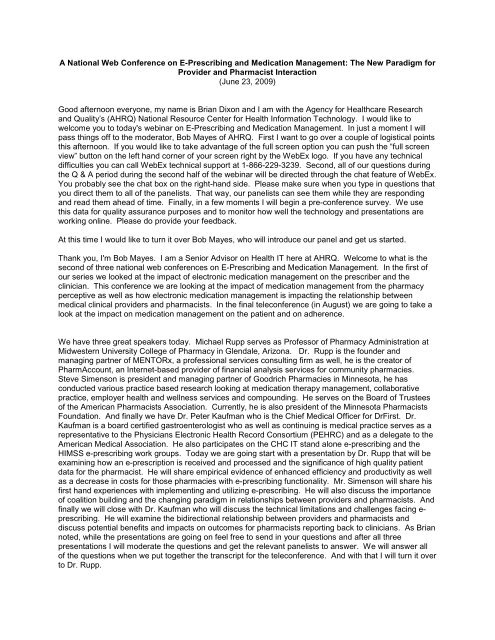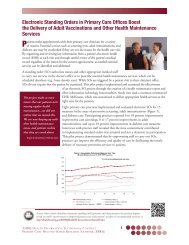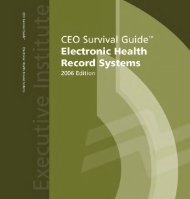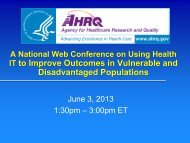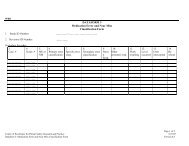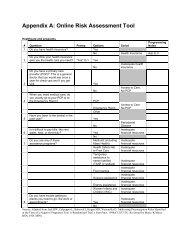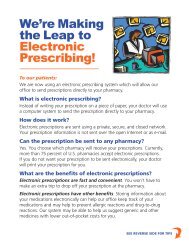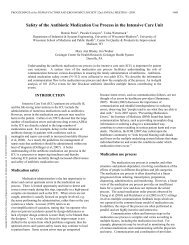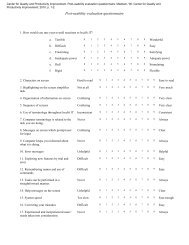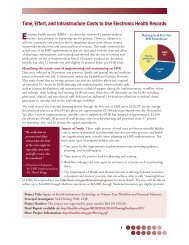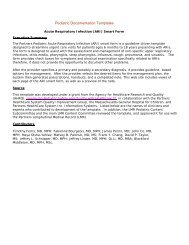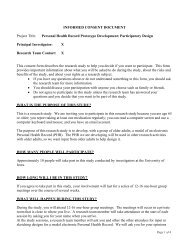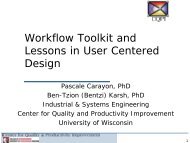A National Web Conference on E-Prescribing and Medication ...
A National Web Conference on E-Prescribing and Medication ...
A National Web Conference on E-Prescribing and Medication ...
You also want an ePaper? Increase the reach of your titles
YUMPU automatically turns print PDFs into web optimized ePapers that Google loves.
A <str<strong>on</strong>g>Nati<strong>on</strong>al</str<strong>on</strong>g> <str<strong>on</strong>g>Web</str<strong>on</strong>g> <str<strong>on</strong>g>C<strong>on</strong>ference</str<strong>on</strong>g> <strong>on</strong> E-<strong>Prescribing</strong> <strong>and</strong> Medicati<strong>on</strong> Management: The New Paradigm forProvider <strong>and</strong> Pharmacist Interacti<strong>on</strong>(June 23, 2009)Good afterno<strong>on</strong> every<strong>on</strong>e, my name is Brian Dix<strong>on</strong> <strong>and</strong> I am with the Agency for Healthcare Research<strong>and</strong> Quality’s (AHRQ) <str<strong>on</strong>g>Nati<strong>on</strong>al</str<strong>on</strong>g> Resource Center for Health Informati<strong>on</strong> Technology. I would like towelcome you to today's webinar <strong>on</strong> E-<strong>Prescribing</strong> <strong>and</strong> Medicati<strong>on</strong> Management. In just a moment I willpass things off to the moderator, Bob Mayes of AHRQ. First I want to go over a couple of logistical pointsthis afterno<strong>on</strong>. If you would like to take advantage of the full screen opti<strong>on</strong> you can push the “full screenview” butt<strong>on</strong> <strong>on</strong> the left h<strong>and</strong> corner of your screen right by the <str<strong>on</strong>g>Web</str<strong>on</strong>g>Ex logo. If you have any technicaldifficulties you can call <str<strong>on</strong>g>Web</str<strong>on</strong>g>Ex technical support at 1-866-229-3239. Sec<strong>on</strong>d, all of our questi<strong>on</strong>s duringthe Q & A period during the sec<strong>on</strong>d half of the webinar will be directed through the chat feature of <str<strong>on</strong>g>Web</str<strong>on</strong>g>Ex.You probably see the chat box <strong>on</strong> the right-h<strong>and</strong> side. Please make sure when you type in questi<strong>on</strong>s thatyou direct them to all of the panelists. That way, our panelists can see them while they are resp<strong>on</strong>ding<strong>and</strong> read them ahead of time. Finally, in a few moments I will begin a pre-c<strong>on</strong>ference survey. We usethis data for quality assurance purposes <strong>and</strong> to m<strong>on</strong>itor how well the technology <strong>and</strong> presentati<strong>on</strong>s areworking <strong>on</strong>line. Please do provide your feedback.At this time I would like to turn it over Bob Mayes, who will introduce our panel <strong>and</strong> get us started.Thank you, I'm Bob Mayes. I am a Senior Advisor <strong>on</strong> Health IT here at AHRQ. Welcome to what is thesec<strong>on</strong>d of three nati<strong>on</strong>al web c<strong>on</strong>ferences <strong>on</strong> E-<strong>Prescribing</strong> <strong>and</strong> Medicati<strong>on</strong> Management. In the first ofour series we looked at the impact of electr<strong>on</strong>ic medicati<strong>on</strong> management <strong>on</strong> the prescriber <strong>and</strong> theclinician. This c<strong>on</strong>ference we are looking at the impact of medicati<strong>on</strong> management from the pharmacyperceptive as well as how electr<strong>on</strong>ic medicati<strong>on</strong> management is impacting the relati<strong>on</strong>ship betweenmedical clinical providers <strong>and</strong> pharmacists. In the final telec<strong>on</strong>ference (in August) we are going to take alook at the impact <strong>on</strong> medicati<strong>on</strong> management <strong>on</strong> the patient <strong>and</strong> <strong>on</strong> adherence.We have three great speakers today. Michael Rupp serves as Professor of Pharmacy Administrati<strong>on</strong> atMidwestern University College of Pharmacy in Glendale, Ariz<strong>on</strong>a. Dr. Rupp is the founder <strong>and</strong>managing partner of MENTORx, a professi<strong>on</strong>al services c<strong>on</strong>sulting firm as well, he is the creator ofPharmAccount, an Internet-based provider of financial analysis services for community pharmacies.Steve Simens<strong>on</strong> is president <strong>and</strong> managing partner of Goodrich Pharmacies in Minnesota, he hasc<strong>on</strong>ducted various practice based research looking at medicati<strong>on</strong> therapy management, collaborativepractice, employer health <strong>and</strong> wellness services <strong>and</strong> compounding. He serves <strong>on</strong> the Board of Trusteesof the American Pharmacists Associati<strong>on</strong>. Currently, he is also president of the Minnesota PharmacistsFoundati<strong>on</strong>. And finally we have Dr. Peter Kaufman who is the Chief Medical Officer for DrFirst. Dr.Kaufman is a board certified gastroenterologist who as well as c<strong>on</strong>tinuing is medical practice serves as arepresentative to the Physicians Electr<strong>on</strong>ic Health Record C<strong>on</strong>sortium (PEHRC) <strong>and</strong> as a delegate to theAmerican Medical Associati<strong>on</strong>. He also participates <strong>on</strong> the CHC IT st<strong>and</strong> al<strong>on</strong>e e-prescribing <strong>and</strong> theHIMSS e-prescribing work groups. Today we are going start with a presentati<strong>on</strong> by Dr. Rupp that will beexamining how an e-prescripti<strong>on</strong> is received <strong>and</strong> processed <strong>and</strong> the significance of high quality patientdata for the pharmacist. He will share empirical evidence of enhanced efficiency <strong>and</strong> productivity as wellas a decrease in costs for those pharmacies with e-prescribing functi<strong>on</strong>ality. Mr. Simens<strong>on</strong> will share hisfirst h<strong>and</strong> experiences with implementing <strong>and</strong> utilizing e-prescribing. He will also discuss the importanceof coaliti<strong>on</strong> building <strong>and</strong> the changing paradigm in relati<strong>on</strong>ships between providers <strong>and</strong> pharmacists. Andfinally we will close with Dr. Kaufman who will discuss the technical limitati<strong>on</strong>s <strong>and</strong> challenges facing e-prescribing. He will examine the bidirecti<strong>on</strong>al relati<strong>on</strong>ship between providers <strong>and</strong> pharmacists <strong>and</strong>discuss potential benefits <strong>and</strong> impacts <strong>on</strong> outcomes for pharmacists reporting back to clinicians. As Briannoted, while the presentati<strong>on</strong>s are going <strong>on</strong> feel free to send in your questi<strong>on</strong>s <strong>and</strong> after all threepresentati<strong>on</strong>s I will moderate the questi<strong>on</strong>s <strong>and</strong> get the relevant panelists to answer. We will answer allof the questi<strong>on</strong>s when we put together the transcript for the telec<strong>on</strong>ference. And with that I will turn it overto Dr. Rupp.
Thank you Bob <strong>and</strong> good afterno<strong>on</strong> every<strong>on</strong>e, as Bob indicated my role in today’s presentati<strong>on</strong> is toprovide the pharmacy perspective from a pharmacy practice based academic research level <strong>and</strong> I willleave the micro level for Steve Simens<strong>on</strong> to address at the store level. I will end this with some prettyspecific practice based recommendati<strong>on</strong>s that we have distilled from some of our research in thisparticular area. To begin, this figure shows the role of SureScripts in c<strong>on</strong>necting electr<strong>on</strong>ic prescriberswith pharmacies through their respective software vendors <strong>and</strong> gateway partners. While this is still aunidirecti<strong>on</strong>al flow of informati<strong>on</strong> from the prescriber to the pharmacy the potential exists for a much morebidirecti<strong>on</strong>al flow of informati<strong>on</strong> <strong>and</strong> we will talk about that later because it really reflects my primaryinterest with this technology. This figure illustrates the path of a c<strong>on</strong>venti<strong>on</strong>al prescripti<strong>on</strong> after it isreceived at the pharmacy. As you can see our tired little claim still has a l<strong>on</strong>g journey ahead throughswitching companies <strong>and</strong> claims processors <strong>and</strong> pharmacy benefits managers during the claimsadjudicati<strong>on</strong> process <strong>and</strong> finally a message is sent back to the stores with payment verificati<strong>on</strong> <strong>and</strong> notuncomm<strong>on</strong>ly a host of additi<strong>on</strong>al acti<strong>on</strong>s required by the pharmacist, which might include priorauthorizati<strong>on</strong>, formulary enforcement, drug utilizati<strong>on</strong> review (DUR) edits <strong>and</strong> so <strong>on</strong>. Also, note that thepharmacy pays for the switch <strong>and</strong> the claims processor for each of these transacti<strong>on</strong>s, which is certainlyan important element to the pharmacist. Now as we then forward this to take a look at electr<strong>on</strong>icprescripti<strong>on</strong>s what you see is that the electr<strong>on</strong>ic prescripti<strong>on</strong>’s path is almost identical except for <strong>on</strong>eimportant difference <strong>and</strong> that is that the pharmacy is charged for the incoming prescripti<strong>on</strong> order, which isfree when it arrives via any other route such as ph<strong>on</strong>e, fax or just carried in by the patient. Thesecharges are particularly modest <strong>on</strong> the order of 25 to 50 cents industry wide, generally, but they add upwhen you are writing 5,000 or more prescripti<strong>on</strong>s per m<strong>on</strong>th. And this probably represents in part theresistance to e-prescribing am<strong>on</strong>gst some pharmacists in particular am<strong>on</strong>g independent communitypharmacies, which as we will see in a moment, lag somewhat behind the adopti<strong>on</strong>s of this technology.Many people believe that we have reached <strong>and</strong> surpassed the tipping point for this technology <strong>and</strong> I thinkthat in the future this will be the dominant means by which prescripti<strong>on</strong>s are transmitted <strong>and</strong> processed inthe community practice setting <strong>and</strong> that is <strong>on</strong>e reas<strong>on</strong> why I <strong>and</strong> many others have committed to improvethis technology <strong>and</strong> to getting rid of little glitches that we still have, <strong>on</strong>ce again when you think about thispoor tortured little claim <strong>and</strong> the path it goes through it is not a surprise that it meets a hiccup or two al<strong>on</strong>gthe way with this advancing technology.This slide reinforces what most of us already know <strong>and</strong> that is that the vast majority of chain pharmaciesare actively receiving <strong>and</strong> processing electr<strong>on</strong>ic prescripti<strong>on</strong>s while independent pharmacies c<strong>on</strong>tinue tolag but it is inevitable that they will be forced to participate whether they want to or not <strong>and</strong> now what wehave passed this tipping point I think we will see adopti<strong>on</strong> to accelerate am<strong>on</strong>g independent pharmacies,but it does raise important questi<strong>on</strong>s, <strong>on</strong>e of which is what are the benefits of e prescribing to pharmacies<strong>and</strong> what benefits do pharmacies recognize, which again is c<strong>on</strong>stitutes a significant amount of work thatwe have d<strong>on</strong>e in this area. Here is a list of potential benefits to pharmacies <strong>and</strong> I guess I would reallypoint out bullet point <strong>on</strong>e, it represents something of a holy grail to the pharmacy. At the very leastelectr<strong>on</strong>ic prescribing ensures that pharmacies can feel relatively certain that they are interpreting whatthe prescriber ordered. Now it still might be wr<strong>on</strong>g, the prescriber might of made a mistake but at leastthe order is legible <strong>and</strong> I think you have to be a pharmacist to really underst<strong>and</strong> what a huge benefit thisis to a pharmacist <strong>and</strong> his or her technicians. In additi<strong>on</strong> to that there are a variety of other potentialbenefits like reducing data entry errors, improving productivity <strong>and</strong> efficiency that hopefully the costs arereduced <strong>and</strong> hopefully all of this will translate into increased time spent with the patients <strong>and</strong> loyaltyam<strong>on</strong>g our patients. Once again some significant benefits to the pharmacy, <strong>and</strong> we have been trying toput some empirical verificati<strong>on</strong> <strong>on</strong> these, potential benefits are what we will talk about next. This chartcomes from a 2004 work sampling study we did of chain pharmacies in Rhode Isl<strong>and</strong>. In this study wehad electr<strong>on</strong>ic prescripti<strong>on</strong>s compared to all others that is h<strong>and</strong>ed in ph<strong>on</strong>ed in <strong>and</strong> faxed in to determineif they really did require less pers<strong>on</strong>al time to receive process <strong>and</strong> fill <strong>and</strong> as this chart illustrates renewalelectr<strong>on</strong>ic prescripti<strong>on</strong>s were associated with significant improvements in processing productivity bothfrom pharmacists <strong>and</strong> technicians with the excepti<strong>on</strong> of pharmacists time dedicated to refill prescripti<strong>on</strong>sfor which there was no difference between electr<strong>on</strong>ic prescripti<strong>on</strong> <strong>and</strong> all others. But in renewedprescripti<strong>on</strong>s the technicians’ time <strong>and</strong> for new prescripti<strong>on</strong>s for both pharmacists <strong>and</strong> technicians therewere significant improvements in the m<strong>on</strong>th of time they had to spend in the various aspects of receiving,dispensing <strong>and</strong> processing prescripti<strong>on</strong>s. This is from the same study <strong>and</strong> it was an indicator ofsatisfacti<strong>on</strong>. It illustrates that both pharmacists’ <strong>and</strong> technicians’ view the electr<strong>on</strong>ic prescripti<strong>on</strong>s as
electr<strong>on</strong>ic prescripti<strong>on</strong>s. Since that study ended NASPA has collaborated with SureScripts to c<strong>on</strong>tinuethat effort in what there are calling their PEER Portal (Pharmacy E-<strong>Prescribing</strong> Experience ReportingPortal).The PEER Portal represents a mechanism of <strong>on</strong>going surveillance of e-prescribing in the communitysetting that could serve as a first alert to problems <strong>and</strong> as this slide indicates, SureScripts intends to issuebulletins <strong>and</strong> alerts to their certified soluti<strong>on</strong>s providers that is for software vendors <strong>and</strong> perhaps even anew certificati<strong>on</strong> requirements based <strong>on</strong> reports generated through the PEER Portal, all intended to bepart of a system wide c<strong>on</strong>tinuous improvement program.So it would be great if we had an awful lot of pharmacies that routinely processing electr<strong>on</strong>ic prescripti<strong>on</strong>that would utilize this PEER Portal to c<strong>on</strong>tinue to provide us with accurate data regarding the c<strong>on</strong>tinuingproblems, issues <strong>and</strong> glitches we have.Several slides reinforcing how very simple, quick <strong>and</strong> easy it is to use the PEER Portal. And really forthose folks that are familiar with for example the Food <strong>and</strong> Drug Administrati<strong>on</strong>'s adverse reacti<strong>on</strong>program, the PEER Portal is somewhat reminiscent of that program intended to be quick <strong>and</strong> easy to use.I wanted to get to our best practice recommendati<strong>on</strong>s these are all from previous research <strong>and</strong>particularly from our 2006 AHRQ funded study. We distill a total of 11 best practice recommendati<strong>on</strong>s.Some of these are directed towards prescribers <strong>and</strong> or their software vendors, <strong>and</strong> some are directed atpharmacy staff <strong>and</strong> some are directed toward other agencies <strong>and</strong> stakeholders in electr<strong>on</strong>ic prescribing. Imight also add before we get into this that a number of these have been since implemented <strong>and</strong> othersare in the process of implementati<strong>on</strong>, which is something we remain very active in.Number <strong>on</strong>e, physicians should perform their own e-Rx data entry. It was observed by a significantnumber of pharmacists <strong>and</strong> technicians in their belief that physicians had delegated this to supportpers<strong>on</strong>nel when they probably shouldn’t, so we str<strong>on</strong>gly recommend that physicians do their own dataentry or at very least review those before they are being transmitted to the pharmacy.The sec<strong>on</strong>d point here, <strong>and</strong> at least in our study, very few of the subscriber side decisi<strong>on</strong> supportsoftware systems had been enabled <strong>and</strong> were routinely being used <strong>and</strong> we’re str<strong>on</strong>gly suggesting thatthose be turned <strong>on</strong>. Many of the errors we saw coming into the pharmacies probably wouldn’t haveoccurred if those decisi<strong>on</strong> support software applicati<strong>on</strong>s had been turned <strong>on</strong>.Third point, all of the electr<strong>on</strong>ic prescripti<strong>on</strong>s for a patient are pharmacists <strong>and</strong> technicians recommendedbe bundled so that when they come in electr<strong>on</strong>ically to a pharmacy, the pharmacy staff knows that this is<strong>on</strong>e of say, three or four electr<strong>on</strong>ic prescripti<strong>on</strong>s that they will be receiving for Mrs. Smith.All three of the recommendati<strong>on</strong>s that you see here really relate to how pharmacies implement electr<strong>on</strong>icprescribing <strong>and</strong> train <strong>and</strong> supervise staff to support it within the practice. My sense is that certainly mostof the chains have already implemented all of these, certainly as independent community pharmaciescome <strong>on</strong>-line we are hoping that they will take a look at these <strong>and</strong> c<strong>on</strong>sider implementing them as well butI believe that most of these have been implemented in the chains, at least the chains that were involvedin our study.Going further, this point <strong>on</strong>e relates to the need for more uniformity am<strong>on</strong>g e-prescribing applicati<strong>on</strong>s thatwould reduce the need for acti<strong>on</strong> at each the receiving pharmacy. Naturally each <strong>on</strong>e of the systemvendors has its own way of doing things, <strong>and</strong> this multiplicity of approach creates some problems at thepharmacy level.Point two comes from many comments received from pharmacy staff that patients have unrealisticexpectati<strong>on</strong>s of e-prescribing, just because the physician has sent the prescripti<strong>on</strong> electr<strong>on</strong>ically to thepharmacy next door doesn't mean that you can walk next door <strong>and</strong> it will be ready. Maybe giving patientsa better more realistic expectati<strong>on</strong> of what this technology can do <strong>and</strong> what it can't do, <strong>and</strong> finally, the
We made a huge step by moving off of Main Street <strong>and</strong> to open a store next to the physicians at theirrequest, <strong>and</strong> that event 35 years ago was the start of working closer to doctors <strong>and</strong> building relati<strong>on</strong>shipsthat have allowed us to do what we do today. Those clinics have l<strong>on</strong>g since been sold to a large systemin our area but because of this initial steps in building those relati<strong>on</strong>ships, they c<strong>on</strong>tinue to improve, whichI am happy to say.It is all about building relati<strong>on</strong>ships. Sometimes you can do it so<strong>on</strong>er than later. We started with earlym<strong>and</strong>ates by parallel virtual machines (PVM) with generic substati<strong>on</strong> as patents expired <strong>and</strong> physicianswere more than happy to set up protocols where we could substitute medicati<strong>on</strong>s that were formularyspecific. And we also picked specific drug classes, H2, prot<strong>on</strong> pump inhibitors, n<strong>on</strong> sedatingantihistamines <strong>and</strong> cortical steroids to have a pre-written medical st<strong>and</strong>ard order that we could reuse <strong>and</strong>save the physician time <strong>and</strong> get the medicati<strong>on</strong> to a patient in a timely fashi<strong>on</strong>. We found that any delayin providing the medicati<strong>on</strong> at the time of service certainly decreased whether the patient would ever takeor use the medicati<strong>on</strong>. We c<strong>on</strong>tinue to build those relati<strong>on</strong>ships everyday <strong>and</strong> it is important to identifystaff at any of the clinics or providers you’re working with to help champi<strong>on</strong> your cause <strong>and</strong> that is criticalfor success. Physicians, we found, do want pharmacists to help manage medicati<strong>on</strong> therapy <strong>and</strong> inreas<strong>on</strong>able small steps they provide the opportunities for us to do that.At the same time that we had to build our clinical skills we started in the 90's with AmericanPharmaceutical Associati<strong>on</strong> (APhA) Project ImPACT (Improve Persistence <strong>and</strong> Compliance with Therapy)<strong>and</strong> we spun that off when we saw there was not <strong>on</strong>ly positive resp<strong>on</strong>se from the community but thephysicians <strong>and</strong> their patients more importantly, to hypertensi<strong>on</strong>, lipid level maintenance, diabetes,osteoporosis <strong>and</strong> smoking cessati<strong>on</strong> after measuring what the community needed. And at that time nothaving access to lab values we used Qli Away M<strong>on</strong>itoring Devices, A1Cs, glucose meters <strong>and</strong> gatheringinformati<strong>on</strong> that was already available, but unavailable to us being independent pharmacists not in theclinic even though we were close to where they practiced.We picked up pharmaceutical care from the University of Minnesota <strong>and</strong> have evolved it into a fairlysuccessful medicati<strong>on</strong> therapy management <strong>and</strong> have changed <strong>and</strong> modified it to our patients' needs.We do unbiased medicati<strong>on</strong> therapy presentati<strong>on</strong>s to local providers <strong>and</strong> physicians <strong>and</strong> the more theyget those presentati<strong>on</strong>s, the more they want them, <strong>and</strong> those c<strong>on</strong>necti<strong>on</strong>s, communicati<strong>on</strong> <strong>and</strong>relati<strong>on</strong>ships built <strong>on</strong> them being able to let go of some of their daily duties such as medicati<strong>on</strong>management.Their regular small successes lead to big l<strong>on</strong>g-term changes, <strong>and</strong> again, that is provides us with accessto more informati<strong>on</strong>. As we were building those the next logical step was trying to get more informati<strong>on</strong>from the clinics, which was getting informati<strong>on</strong> through their electr<strong>on</strong>ic medical records -- lab, diagnosis,things that were unavailable at that time.With that there was about three years of legal struggles c<strong>on</strong>vincing the attorneys, not the management<strong>and</strong> not the medical providers that what we redoing was a good idea. When they finally got comfortablewe had a medical st<strong>and</strong>ing orders to order labs <strong>and</strong> to refill prescripti<strong>on</strong>s <strong>and</strong> also access those electr<strong>on</strong>icmedical records whenever it was clinically appropriate.Interestingly enough, they were more interested in us okaying prescripti<strong>on</strong>s <strong>and</strong> again taking c<strong>on</strong>trol <strong>and</strong>letting us manage those medicati<strong>on</strong> therapy issues than all the other things that we really thought wereimportant like access to clinical data that helps provide better care to our patients.Patient surveys have c<strong>on</strong>tinually <strong>and</strong> c<strong>on</strong>sistently indicated that our pharmacist have provided a higherlevel of patient satisfacti<strong>on</strong>, patient educati<strong>on</strong> <strong>and</strong> attainment of treatment goals then our peers <strong>and</strong> I thinkthat is due in a large part to the added informati<strong>on</strong> that we have. As this service has value to the clinicswe c<strong>on</strong>tract with we get paid a c<strong>on</strong>sultant fee to provide these patient based services, so they also placevalue <strong>on</strong> what we do <strong>and</strong> allowing to give up that part of their practice of managing medicati<strong>on</strong> up to acertain point.
Part of the goal <strong>and</strong> effort is too appropriately use EMRs, there are a lot if system legal requirements,your staff needs c<strong>on</strong>stant training c<strong>on</strong>centrating <strong>on</strong> who what where <strong>and</strong> when the system can beaccessed. And you have to c<strong>on</strong>vince them that you are close, safe guarders of the informati<strong>on</strong> <strong>and</strong> youalso have to address the c<strong>on</strong>cerns of staff <strong>on</strong> your end that you have inappropriate access to theirrecords <strong>and</strong> they have every opti<strong>on</strong> of opting in or out, so pharmacists d<strong>on</strong>’t access records of employeeseven though it is appropriate clinically.The terminals are in semiprivate areas <strong>and</strong> it’s Intranet based with a password <strong>and</strong> log in informati<strong>on</strong> <strong>and</strong>you can log into any patient's chart that is in the system. There's about 350,000 patients <strong>and</strong> not <strong>on</strong>ly didthe three adjacent clinics give us that informati<strong>on</strong>, but also they gave us access to other patients thatweren’t going to those clinics. And proven again, there's no questi<strong>on</strong> pharmacists can be trusted tomaintain patient privacy.Medicati<strong>on</strong> questi<strong>on</strong>s that we answer every day are innumerable. We c<strong>on</strong>stantly c<strong>on</strong>firm diagnosis, offlabel use, make sure the latest labs have been ordered or order them. And they're not too manyquesti<strong>on</strong>s we can answer with good patient triage you really need to access that electr<strong>on</strong>ic medicalrecord. It’s part of our daily workflow <strong>and</strong> we almost take it for granted that we are doing that every day.The EMR charting is being d<strong>on</strong>e not <strong>on</strong>ly to a document acti<strong>on</strong>s <strong>and</strong> care but to share with otherproviders to provide better c<strong>on</strong>tinuity of care. Physicians realize that <strong>and</strong> as we get access to thatinformati<strong>on</strong> we certainly buy into that c<strong>on</strong>cept that we are adding to c<strong>on</strong>tinuity of care <strong>and</strong> looking for gapsin that care.It helps health dollars be spent more ec<strong>on</strong>omically <strong>and</strong> efficiently <strong>and</strong> we can provide more c<strong>on</strong>sistentproven patient outcomes helping the physician manage the medicati<strong>on</strong> <strong>and</strong> it is all by our access to theelectr<strong>on</strong>ic medical records. We can look at prescripti<strong>on</strong>s filled at other pharmacies which means we havea more complete record. A record of things that are sent to mail order pharmacies, specialty pharmacieswhich is getting more prevalent, looking at specialist c<strong>on</strong>sulates <strong>and</strong> do the rec<strong>on</strong>ciling with hospitaldischarge <strong>and</strong> rehabilitati<strong>on</strong> <strong>and</strong> nursing home discharge reports <strong>and</strong> also dealing with the problem ofmaking sure there is an appropriate narcotic care plan <strong>and</strong> agreements with a <strong>and</strong> we know what therules are that the patients are supposed to follow <strong>and</strong> hopefully this leads to a future of better care.Who should c<strong>on</strong>trol EMR access? This is a fairly compelling <strong>on</strong>e, my pers<strong>on</strong>al belief is that patientsshould have access <strong>and</strong> c<strong>on</strong>trol of their own pers<strong>on</strong>al health history. Healthcare instituti<strong>on</strong>s have proventhat entire healthcare team benefits as a patient’s medical outcomes when more people <strong>and</strong> providershave access to that record.Documentati<strong>on</strong> in communicati<strong>on</strong> by pharmacists is much improved <strong>and</strong> adds to the care of other healthcareproviders.The nice thing about Internet access, you can access that technology anywhere <strong>and</strong> it is not cite specific,as currently in many situati<strong>on</strong>s like the VA or other large health systems you do have access but themoment you step out the door other community health providers do not have access to those records. Itis technologically possible to look into making sure it is available to all appropriate providers. With patientaccess <strong>and</strong> c<strong>on</strong>tact proven to be more frequent <strong>and</strong> c<strong>on</strong>sistent at the local pharmacy, EMR access at thesite <strong>and</strong> better care leads to more timely clinical decisi<strong>on</strong>s by the pharmacists leading to better patientoutcomes.EMR prescribing versus electr<strong>on</strong>ic prescribing, we started e-prescribing three years ago <strong>and</strong> we're not aSureScripts e-prescribing utilizer at that point. We were used to getting more informati<strong>on</strong> so I have amore skeptical view of e-prescribing. It has added to patient safety <strong>and</strong> we certainly get more legiblescripts, but we still have questi<strong>on</strong>s that we have become used to asking that are not answered <strong>on</strong> thoseprescripti<strong>on</strong>s. Currently when we get an electr<strong>on</strong>ic medical record generated prescripti<strong>on</strong>, we get theallergies, who the order was entered by <strong>and</strong> what their credentials are, the time of the order, medicalrecord number, which sometimes helps, <strong>and</strong> the clinic name <strong>and</strong> address plus the provider’s specialty,which we believe all help.
I apologize for the clarity of this slide but this is an example of patient record, which pretty much as itcome though this what we are going to see <strong>and</strong> this is the small subset of data that we receive.Pharmacists have desired more complete patient informati<strong>on</strong> for many years but pharmacists can say thatthey have all the patient medical <strong>and</strong> clinical informati<strong>on</strong> most of the time, far too few pharmacistsregularly get to use electr<strong>on</strong>ic medical records to provide care <strong>and</strong> most would if they could. Beginningwith diagnosis codes <strong>and</strong> initial lab values pharmacists can better <strong>and</strong> more efficiently managemedicati<strong>on</strong> therapy. With the implementati<strong>on</strong> of the pharmacists MTM the specific patient informati<strong>on</strong> iseven more necessary to make good patient care clinical decisi<strong>on</strong>s. It is amazing that pharmacists haved<strong>on</strong>e so well for so l<strong>on</strong>g navigating <strong>and</strong> making medicati<strong>on</strong> decisi<strong>on</strong>s in partial darkness.Community pharmacy with EMR access have the ability to save prescriber precious times, to decreaseunnecessary provider visits <strong>and</strong> labs <strong>and</strong> lead to increased patient satisfacti<strong>on</strong> for all providers.With the advent of MTM, EMRs have come to be an excellent tool to making our process of MTM moreefficient <strong>and</strong> more prepared when the patient comes into for their visit. Data can be grouped <strong>and</strong>gathered by category <strong>and</strong> distinct sets like labs <strong>and</strong> in counters unlike paper charts. And in preparati<strong>on</strong>for a medicati<strong>on</strong> therapy review, the EMR lets our pharmacist check for all recent lab of values, theevaluati<strong>on</strong> of medicati<strong>on</strong> appropriateness, problems, initial outcomes <strong>and</strong> drug induced problems.Comparing EMR medicati<strong>on</strong>s records against the pharmacy records for compliance in dosing or againstshared pharmacy records from other pharmacists, that are routinely provided for patient that our notroutinely ours.We check provider charts for patient outcomes <strong>and</strong> c<strong>on</strong>cerns, complaints, diagnosis <strong>and</strong> provider goals<strong>and</strong> follow-ups. We check for visit timing <strong>and</strong> needed procedures <strong>and</strong> follow-up determined by bestpractice parameters. The patient pers<strong>on</strong>al medicati<strong>on</strong> record can partially be completed EMR data <strong>and</strong>pharmacy system informati<strong>on</strong> by the core elements of MTM.At the time of the patient visit, you can review all ph<strong>on</strong>e calls made to the patient <strong>and</strong> specialist referrals<strong>and</strong> documentati<strong>on</strong> they are all available in the EMR. Questi<strong>on</strong>s developed <strong>and</strong> unanswered can beresearched <strong>on</strong> the EMR <strong>and</strong> related to the patient at the time of visit. Previous patient c<strong>on</strong>sults,recommended test <strong>and</strong> labs. Patients underst<strong>and</strong>ing of physician goals can be restated or re-related ifthey were misunderstood.The initial medicati<strong>on</strong> acti<strong>on</strong> plans started pre visit with EMR informati<strong>on</strong> is completed with face-to-facevisit with the pharmacists triage <strong>and</strong> rec<strong>on</strong>ciliati<strong>on</strong> with the patient <strong>and</strong> their underst<strong>and</strong>ing of theirmedicati<strong>on</strong>. Data that is recommended in the MTM core elements are readily attained in the EMR,patient name, date of birth <strong>and</strong> primary physician <strong>and</strong> c<strong>on</strong>tact informati<strong>on</strong>, most current activemedicati<strong>on</strong>s, patient disease states <strong>and</strong> diagnosis. And post the visit the EMR is also utilized,documentati<strong>on</strong> is available <strong>and</strong> referral to smart sets <strong>and</strong> best care practices, we are able to use those.Your MTM referral from the provider is an open order we can close <strong>and</strong> document our acti<strong>on</strong>s.Recommendati<strong>on</strong>s in a report to you provider can be d<strong>on</strong>e in the EMR system <strong>and</strong> put in the physician'swork queue which in most cases are answered or addressed by the end of the day. With st<strong>and</strong>ingmedical orders we can recommend future labs, medicati<strong>on</strong> changes <strong>and</strong> refills can be authorized <strong>and</strong>other physicians <strong>and</strong> clinical providers c<strong>on</strong>tacted. Charting our documentati<strong>on</strong>s, medicati<strong>on</strong> order notesin results of our MTM visits are also available to other providers.Duplicate documentati<strong>on</strong> is always time c<strong>on</strong>suming <strong>and</strong> inefficient, so not being able to use the electr<strong>on</strong>icmedical record to bill is currently a drawback. Those extra steps make MTM a less efficient process <strong>and</strong>less ec<strong>on</strong>omically viable. And the next step would be to use the electr<strong>on</strong>ic records system to be able tobill for MTM visits. The benefits of EMR are quite large.Patient informati<strong>on</strong> normally collected by pharmacist is usually incomplete <strong>and</strong> actively fades with time<strong>and</strong> age of the patient. These are up to date in the EMR. Limited m<strong>on</strong>itoring <strong>and</strong> lab availability <strong>and</strong>unfunded cost associated with pharmacy testing are also factors. Costs include time <strong>and</strong> m<strong>on</strong>itoring
machines <strong>and</strong> supplies <strong>and</strong> also the EMR avoids unnecessary duplicati<strong>on</strong> of labs already duplicated bythe clinic. The physician care plan <strong>and</strong> SOAP (subjective objective assessment <strong>and</strong> plan) notes areinvaluable in completing medicati<strong>on</strong> acti<strong>on</strong> plans for patients. They can reinforce goals <strong>and</strong> strategiesalready provided by the provider.Most physicians <strong>and</strong> providers debrief their work crew every day <strong>and</strong> the timeline of communicati<strong>on</strong> isexcellent. Pharmacists <strong>and</strong> most patients do not like days or weeks for authorizati<strong>on</strong> of therapy changes.EMR communicati<strong>on</strong> is listed in the patient's chart for future reference <strong>and</strong> all acti<strong>on</strong>s taken by all partiesare documented. As grants to physicians are given through the new Federal stimulus packages, I believeit is important that other healthcare providers should be required to have access when they take thesefunds.Gathering informati<strong>on</strong> <strong>and</strong> collaborating independently is not <strong>on</strong>ly time c<strong>on</strong>suming but can also befrustrating. We believe when we are in the EMR system we are working within the system <strong>and</strong> notparallel to it or c<strong>on</strong>flicting with it. Physicians are very used to <strong>and</strong> comfortable with the day-to-day flow<strong>and</strong> the use of the EMR <strong>and</strong> we're just another c<strong>on</strong>sultant that rely <strong>on</strong> to provide good patient care thatworks within the system.Patients realize that we're working within the system not outside or parallel to it. Pharmacists will have anew role as the professi<strong>on</strong>s roll out a new medical home model. Access to the patient’s EMR is critical infulfilling what the pharmacist are trained to do, which is optimizing medicati<strong>on</strong> outcomes. And I pers<strong>on</strong>allybelieve physicians are getting more comfortable with letting pharmacists manage those medicati<strong>on</strong>outcomes. Making critical decisi<strong>on</strong>s <strong>and</strong> making good clinical decisi<strong>on</strong>s are extremely important havingthe right informati<strong>on</strong> at the right time.Thank you <strong>and</strong> back to you, Bob.Thank you, Steve. I did notice <strong>on</strong>e questi<strong>on</strong>, what is MTM?I will answer very briefly. It st<strong>and</strong>s or medicati<strong>on</strong> therapy management <strong>and</strong> it is a label that is being usedin the pharmacy professi<strong>on</strong> to talk to a variety of cognitive services that a pharmacist can bring to thetable in helping individuals manage their medicati<strong>on</strong> therapy. So just a quick answer for MTM. And let'sgo ahead <strong>and</strong> have our final presentati<strong>on</strong> by Dr. Kaufman <strong>and</strong> then we’ll open it up for questi<strong>on</strong>s althoughyou can certainly type your questi<strong>on</strong>s in as they come to you <strong>and</strong> I will feed them back to the panelistafter the final presentati<strong>on</strong>. Dr. Kaufman?Thank-you very much. I am going to address some of what was hinted at by Dr. Rupp, earlier in thediscussi<strong>on</strong> about the bidirecti<strong>on</strong>al communicati<strong>on</strong>. There is some bidirecti<strong>on</strong>al communicati<strong>on</strong> now <strong>and</strong>there are st<strong>and</strong>ards from that <strong>and</strong> the Dr. Rupp <strong>and</strong> I both work <strong>on</strong> the NCPDP panels developing thosest<strong>and</strong>ards panels, some of which are accepted but they're not in wide use for a variety of reas<strong>on</strong>s. Andso we will look at some of that <strong>and</strong> also what is coming. Let me just review the benefits for the physicians<strong>and</strong> the pharmacists, I’m going to leave the payers out of it. I hope there are n<strong>on</strong>e of them <strong>on</strong> the call butas a practicing physician, we view the payers as the enemy.For physicians the patient’s informati<strong>on</strong> is available. The patient’s medicati<strong>on</strong> history, prescripti<strong>on</strong> benefitplan, which includes formulary informati<strong>on</strong> can make it a lot easier at the point of care to prescribeknowing what the clinical alerts are going to be <strong>and</strong> being able to correct the prescripti<strong>on</strong> that willgenerate a clinical alert <strong>and</strong> being able to find out the patient was already <strong>on</strong> something similar or was<strong>and</strong> either had an adverse reacti<strong>on</strong> or it wasn't effective for them or it wasn't covered by their insurance.So it makes it easier to prescribe the correct things in the first place <strong>and</strong> then generate an electr<strong>on</strong>ic newprescripti<strong>on</strong> that giving the pharmacist to clean prescripti<strong>on</strong>. Also, renewal resp<strong>on</strong>ses can come inelectr<strong>on</strong>ically <strong>and</strong> while this is not viewed by physicians as particularly helpful, it is viewed astremendously helpful by their staff. We know practices that have decreased FTEs (full time employees)because the prescripti<strong>on</strong>s come in electr<strong>on</strong>ically rather than by the fax machine <strong>and</strong> they d<strong>on</strong>’t have topull the chart for every<strong>on</strong>e that comes in. So we are c<strong>on</strong>firming prescripti<strong>on</strong> benefits <strong>and</strong> reviewing the
patient history <strong>and</strong> eliminating poor h<strong>and</strong>writing errors which is a problem for physicians too when we geta call back at seven at night <strong>and</strong> reducing those pharmacy call backs. You are also able to reviewprescripti<strong>on</strong> history <strong>and</strong> you have a prescripti<strong>on</strong> where the physician has viewed that as well <strong>and</strong>receiving renewal requests electr<strong>on</strong>ically to the physician, in additi<strong>on</strong>, getting electr<strong>on</strong>ic new prescripti<strong>on</strong><strong>and</strong> I think Dr. Rupp may have hinted that the number of pharmacies that need to print this out <strong>and</strong>reenter them after they come in electr<strong>on</strong>ically has dwindled to near nothing <strong>and</strong> I think that is not thecase. I think there is still at least <strong>on</strong>e large chain that is having to do that as they roll out new softwarethat will eliminate that <strong>and</strong> also getting the resp<strong>on</strong>ses from the prescripti<strong>on</strong> renewals electr<strong>on</strong>ically aswell.But the most important thing is getting a clean prescripti<strong>on</strong> in, so reducing the time spent <strong>on</strong> faxes <strong>and</strong>calls <strong>and</strong> the ideal thing when talking about bidirecti<strong>on</strong>al communicati<strong>on</strong> is eliminating as much extracommunicati<strong>on</strong> that is not needed as possible to allow more patient c<strong>on</strong>sulting time.Dr. Rupp showed that slide earlier where he said that pharmacists feel that they have less of arelati<strong>on</strong>ship with the patient but if they have more time to talk to the patients because the other issues <strong>and</strong>the prescripti<strong>on</strong>s are taken care of by this, that will really be good. Also improving patient c<strong>on</strong>veniencemight bring the patient to the pharmacy <strong>and</strong> pharmacies do make m<strong>on</strong>ey when the patients w<strong>and</strong>eraround waiting for their prescripti<strong>on</strong> but getting the patient in there in the first place is very h<strong>and</strong>y. Talkingabout the relati<strong>on</strong>ship between providers <strong>and</strong> pharmacies, currently prescripti<strong>on</strong>s come by paper, ph<strong>on</strong>e,fax <strong>and</strong> electr<strong>on</strong>ically. Most prescripti<strong>on</strong>s are coming electr<strong>on</strong>ically which isn’t that bad but it breaks downwhen there is a need for clarificati<strong>on</strong> due to interacti<strong>on</strong>, formulary issue, legibility or patient c<strong>on</strong>cern <strong>and</strong>e-prescribing limits those first three as l<strong>on</strong>g as it is an appropriate electr<strong>on</strong>ic prescribing system.And bidirecti<strong>on</strong>al messages, with the new prescripti<strong>on</strong>s for the physicians to the pharmacists <strong>and</strong> therenewal with pharmacist to the physicians <strong>and</strong> then from the physician back to the pharmacist <strong>and</strong> so<strong>on</strong>to be more, as we will discuss a little bit later.Some of these slides you have seen before but not this <strong>on</strong>e but I am going to just blast through these butI just wanted to show you what is happening with electr<strong>on</strong>ic prescribing. Here is a hyperbolic curve, ageometric increase in the number of prescripti<strong>on</strong>s going electr<strong>on</strong>ically. Now unfortunately this is just atiny fracti<strong>on</strong> of the 4 billi<strong>on</strong> prescripti<strong>on</strong>s that are written per year except in Massachusetts where 1 inevery 5 prescripti<strong>on</strong>s is electr<strong>on</strong>ic but in the rest of the country it is a small fracti<strong>on</strong> but as you can see it isincreasing very quickly, the total messaging volume, prescripti<strong>on</strong> benefit checks where the system checks<strong>and</strong> finds out if the patient has coverage <strong>and</strong> what is covered by the benefit <strong>and</strong> you can pull down theslides <strong>and</strong> read this stuff later. Pulling down medicati<strong>on</strong> history, routing -- this is the slide you saw earlier,how many are renewals <strong>and</strong> how many are new prescripti<strong>on</strong>s. And the number of prescribers, over100,000 prescribers, I think SureScripts presented yesterday that there are 120,000 doctors writingprescripti<strong>on</strong>s electr<strong>on</strong>ically now, <strong>and</strong> that is great. There are <strong>on</strong>ly about 500,000 doctors practicing. Thenumber of states that provide data or data is provided, the blue, if you can read this your eyes are betterthan mine, is 60 percent or more all of these states especially in the east, <strong>and</strong> the far Midwest, have over60 percent medicati<strong>on</strong> history coming back, <strong>and</strong> everything but a few states have over 40 percent. This isinteresting that California is behind because they are usually ahead in electr<strong>on</strong>ic stuff.So in adopti<strong>on</strong>, this is a little of an older slide, I should thank SureScripts for a lot of the data in theseslides, they're were willing to l<strong>on</strong>e this to us <strong>and</strong> a lot of the data from these slides are from them. As Isaid there are now about 100,000 prescribers in the network <strong>and</strong> significant increases in the growth in thelast several years at a geometric rate. And back to summarizing e-prescribing in general, we talked aboutthe great out advantages <strong>and</strong> also the clinical alerts which are an advantage to the patient but also thedoctor too, eliminating callbacks <strong>and</strong> I know that there are not all lot of doctors <strong>on</strong> this call but doctorsreally do want to practice good medicine <strong>and</strong> treat their patients well <strong>and</strong> being able to get this informati<strong>on</strong>at the point of care is c<strong>on</strong>sidered a positive to doctors. Documentati<strong>on</strong> as so<strong>on</strong> as you do anythinginvolving this communicati<strong>on</strong>, it is documented in your electr<strong>on</strong>ic chart for you whether you are usingEMR <strong>and</strong> it is passed over or if you just have electr<strong>on</strong>ic prescribing. And speed, yes speed, electr<strong>on</strong>icprescribing is actually faster than paper much to the chagrin of all the people who have been saying thatfor the past couple of years they do not want to use e-prescribing because it will slow them down.
To summarize the advantages to pharmacists, clean prescripti<strong>on</strong>s <strong>and</strong> workflow <strong>and</strong> improves patientc<strong>on</strong>venience <strong>and</strong> also increases prescripti<strong>on</strong> volume. And I wrote more to come here but that wasexplained by Dr. Rupp <strong>and</strong> I think I have a slide <strong>on</strong> this later but I might have taken it out. Improvedpatients' safety <strong>and</strong> cost savings for the pharmacy as you saw in the study that was d<strong>on</strong>e by Dr. Ruppamd presented by him.Focusing <strong>on</strong> the value to the pharmacies, the pharmacies can regain c<strong>on</strong>trol of their business. There'sover 500 milli<strong>on</strong> renewal transacti<strong>on</strong>s electr<strong>on</strong>ically. Pharmacists can save 3 to 4 hours a day <strong>on</strong>prescripti<strong>on</strong> issues between the calls <strong>and</strong> slower paper prescripti<strong>on</strong>s. And substituting inefficient callback with efficient electr<strong>on</strong>ic computerized communicati<strong>on</strong>, which are coming up so d<strong>on</strong>’t hang up yet.And achieve significant return <strong>on</strong> investment as Dr. Rupp presented earlier, it is financially viable bypharmacies to use electr<strong>on</strong>ic prescribing. Elevate the role of the pharmacist by providing more time forpatient counseling <strong>and</strong> maintaining the professi<strong>on</strong>al role of the pharmacist in DUR, also advancing someof that DUR earlier in the process to give the prescriber some of the informati<strong>on</strong> at the point of care <strong>and</strong>reduce the need for DUR. And improving customer satisfacti<strong>on</strong> <strong>and</strong> care, fewer insurance eligibilityissues were the patient has to leave the pharmacy without any medicine at all while the pharmacist dealswith a doctor <strong>and</strong> changes a prescripti<strong>on</strong> to something that w<strong>on</strong>’t cost the patient $140 out of pocket.Fewer insurance formulary, which is kind of right there, less wait time for renewals, more time for patientpharmacy interacti<strong>on</strong>s <strong>and</strong> reduces the potential for medicati<strong>on</strong> errors.So in general let’s talk about some of the limitati<strong>on</strong>s <strong>and</strong> challenges for physician practices. Costs, thereis an upfr<strong>on</strong>t cost for starting electr<strong>on</strong>ic prescribing <strong>and</strong> that includes both the software <strong>and</strong> the hardware.And infrastructure. There are many practices, I’m in Maryl<strong>and</strong> <strong>and</strong> every<strong>on</strong>e in Maryl<strong>and</strong> has high-speedin their office but I know in many other parts of the country high-speed Internet is not that available <strong>and</strong>it's really hard to do electr<strong>on</strong>ic prescribing over a dial up line. It is to the point of painful if you are using itfor all of you prescripti<strong>on</strong>s. But it works okay for those nights <strong>and</strong> weekends where you have to write <strong>on</strong>ehere or there. The deployment of it, the system needs to be rolled out, it needs to be trained, staff needto get involved, it has to get interfaced with other software, that is a limit as well <strong>and</strong> fitting into the office’sworkflow. As I was discussing this in a c<strong>on</strong>versati<strong>on</strong> earlier today I think that the soluti<strong>on</strong> is to have aflexible enough system that it can fit the current workflow but a str<strong>on</strong>g enough system that the practice willbe willing to then modify their workflow a little bit after they get sold <strong>and</strong> e-prescribing to start doing thingsmore efficiently the way that electr<strong>on</strong>ics will allow them to <strong>and</strong> kind of move away from their paperworkflow, which could then slow them down when they are doing the electr<strong>on</strong>ic system, <strong>and</strong> it was alsomenti<strong>on</strong> earlier that the biggest limitati<strong>on</strong>, <strong>on</strong>ce this is taken care of is failed scripts. And much blamewas placed earlier <strong>on</strong> physicians, when a patient shows up at the pharmacy <strong>and</strong> fortunately pharmacistsare saying, mostly, that I can't find your prescripti<strong>on</strong>, <strong>and</strong> not, your doctor never sent it, but there certainlyin the past there were people that would show up they would say that the doctor never sent it, <strong>and</strong> in thereviews of these prescripti<strong>on</strong>s for the thous<strong>and</strong>s of prescripti<strong>on</strong>s that my company has reviewed, 100percent of them had reached the pharmacy computer system.So that is an issue <strong>and</strong> needs to be corrected by you folks in the audience. So let’s talk about what isthere <strong>and</strong> what is coming in terms of bidirecti<strong>on</strong>al communicati<strong>on</strong>.The st<strong>and</strong>ards are complete <strong>and</strong> accepted, NCPDP script 10.X has a lot of this stuff in it just nobody isusing it yet. There bidirecti<strong>on</strong>al user st<strong>and</strong>ards not yet in full use. Currently used, new Rx, refilledrequest <strong>and</strong> refill resp<strong>on</strong>se. Other message types that are not used in wide use but are really helpful areIT, cancel prescripti<strong>on</strong> <strong>and</strong> cancel resp<strong>on</strong>se. So for example, I wrote a prescripti<strong>on</strong> <strong>and</strong> I want to cancel it<strong>and</strong> I sent off a void for the prescripti<strong>on</strong>, sends out a cancel Rx <strong>and</strong> then I get a message back from thepharmacist that says “great, I got it in time, patient hasn’t come to pick it up,” or “thanks for sending thispatient got his first fill <strong>and</strong> I will cancel the refills,” or “why are you sending this to me m<strong>on</strong>ths later, patientalready got all their refills.” And Rx change, so if for whatever reas<strong>on</strong> the pharmacist wants to change theprescripti<strong>on</strong> or there is a problem with the prescripti<strong>on</strong> can send the message electr<strong>on</strong>ically to change theprescripti<strong>on</strong> <strong>and</strong> the resp<strong>on</strong>se can I either be “no, no need for change,’ or “I accept your change.” Thiscan save a tremendous amount of time <strong>and</strong> transcripti<strong>on</strong> <strong>and</strong> verbal transcripti<strong>on</strong> errors where somebodycan't underst<strong>and</strong> the voice <strong>on</strong> the other end of the ph<strong>on</strong>e <strong>and</strong> that could be a problem.
Rx fill was tested in 2006 by multiple systems as part of the CMS (Centers for Medicare & MedicaidServices) has AHRQ funded e-prescribing st<strong>and</strong>ards testing <strong>and</strong> proven to work <strong>and</strong> nobody is sendingRx fill messages <strong>and</strong> I would be happy if some<strong>on</strong>e wants to send a message saying that they are sendingRx fill messages, <strong>and</strong> frankly the e-prescribing vendors are forced to add features to their software but thee-prescribing pharmacy vendors are not, <strong>and</strong> this should be requirement for pharmacies to send. Whatwould be even more important is to add a no fill that the pharmacy shelved that prescripti<strong>on</strong> <strong>and</strong> did notfill for the patient so that when the message is sent back to the PBN, reimbursing the PBN also be sentback to the prescriber saying the patient never picked up the prescripti<strong>on</strong> that is now 10 days or twoweeks later. Because unless you get 100 percent Rx fill resp<strong>on</strong>ses, it’s really the no fill resp<strong>on</strong>se that arenecessary.And the final huge <strong>on</strong>e held up by the PBN’s is prior authorizati<strong>on</strong>. To be able to get the priorauthorizati<strong>on</strong> at the point of care <strong>and</strong> 80 percent of these can be immediately adjudicated so theprescripti<strong>on</strong> can be sent with a prior authorizati<strong>on</strong>, it would save the pharmacist time, the patient time <strong>and</strong>it would save that practice time.And so the benefits of the bidirecti<strong>on</strong>al occasi<strong>on</strong> are obvious. The efficiency can be automated, <strong>and</strong> c<strong>and</strong>o <strong>on</strong>e click <strong>and</strong> instead of a whole message, <strong>and</strong> also time shifting. You d<strong>on</strong>’t have to catch thephysician between patients to get an answer.It could be a detriment however if the questi<strong>on</strong> is urgent, so there will still be a reas<strong>on</strong> for ph<strong>on</strong>e calls.There is no language issue, as I menti<strong>on</strong>ed earlier, legibility <strong>and</strong> verbal misunderst<strong>and</strong>ings, <strong>and</strong> if thesystem is easier <strong>and</strong> you d<strong>on</strong>'t need to get the physicians or the physician’s staff <strong>on</strong> the ph<strong>on</strong>e,pharmacists <strong>and</strong> physicians are more likely to communicate rather than blow it off because they d<strong>on</strong>'twant to hassle with it or they are busy.So the impacts <strong>on</strong> outcome for pharmacists reporting back to clinicians electr<strong>on</strong>ically the likelihood of aresp<strong>on</strong>se automated recording of the bidirecti<strong>on</strong>al communicati<strong>on</strong>, it is documented. Improverelati<strong>on</strong>ships between pharmacists <strong>and</strong> physicians resulting from this communicati<strong>on</strong>. That is anotherthing that was menti<strong>on</strong>ed earlier by Dr. Rupp that the communicati<strong>on</strong> between pharmacists <strong>and</strong>physicians could be better. When I started my practice over 20 years ago it was much better than Iactually talked to pharmacists where it is now rare.And improved patient care in result of the communicati<strong>on</strong>s.Hang in there, this is almost d<strong>on</strong>e.So in summary, the routing of electr<strong>on</strong>ic prescripti<strong>on</strong>s is a totally electr<strong>on</strong>ic transmissi<strong>on</strong> of theprescripti<strong>on</strong> informati<strong>on</strong> from the prescribers fingertips to the pharmacists eyes, no reentering ofinformati<strong>on</strong>, computer to computer, electr<strong>on</strong>ic data interchanged <strong>and</strong> no paper unless required by law or ifso <strong>on</strong>e chooses. And vice versa, bidirecti<strong>on</strong>al with new requests coming electr<strong>on</strong>ically, as well.It is not simply e-prescribing these days. As was menti<strong>on</strong>ed earlier CHIX is something that is coming <strong>and</strong>will be not just change requests but other messages back <strong>and</strong> forth between the doctors <strong>and</strong> thepharmacists sent electr<strong>on</strong>ically through these currently existing systems.Prescripti<strong>on</strong> histories <strong>and</strong> eligibility in formulary, <strong>and</strong> somewhat but not completely analogues to the<strong>on</strong>line claims adjudicati<strong>on</strong> but using an NCPDP script st<strong>and</strong>ard. That is all I have to say <strong>and</strong> we will all betaking questi<strong>on</strong>s. Thank you very much.Thank you Doctor Kaufman, this is Bob Mayes again. We have gotten several questi<strong>on</strong>s <strong>and</strong> rather thango through each individual I have grouped them. I am just going to start sort of from <strong>on</strong>e of the first <strong>on</strong>esthat came in.
Several folks were interested in how this move toward electr<strong>on</strong>ic medicati<strong>on</strong> management <strong>and</strong> e-prescribing impacts the role of the patients in the process. Each of the presenters talked a little bit aboutpotentially whether or not the patient was sort of turffed out of it, or whatever. So maybe each of youcould speak just briefly as to what you seen the role of the patient being as we move towards a fullyintegrated electr<strong>on</strong>ic medicati<strong>on</strong> management systems.This is Dr. Rupp, I guess I could start <strong>on</strong> that <strong>and</strong> I assume Doctor Kaufman <strong>and</strong> / or Steve particularlywill want to chime in.It seems ir<strong>on</strong>ic to me in the study we did, the AHRQ study, the technology that clearly c<strong>on</strong>served toimprove the exchange of informati<strong>on</strong> efficiently can at the same time alienate <strong>and</strong> distance people. Andparticularly that very surprising observati<strong>on</strong> that we made that by eliminating that physical h<strong>and</strong>off of thepaper prescripti<strong>on</strong> order from a physician to the patient in the office <strong>and</strong> by eliminating the vestige of anearlier era we have apparently eliminated something important. That exchange represented anopportunity for an encounter <strong>and</strong> for exchange of informati<strong>on</strong> <strong>and</strong> reinforcement of what the physician isdoing <strong>and</strong> why, <strong>and</strong> as a result, kind of engaging the patient as an active participant <strong>and</strong> it seems as weadopt these technologies it is kind of the rule of unexpected results that will have these kind ofunexpected side effects, I guess, if you will.From my perspective, the technologies we are talking about provide additi<strong>on</strong>al informati<strong>on</strong>, decisi<strong>on</strong>relevant informati<strong>on</strong> at the point of care for a pharmacist to supports the provisi<strong>on</strong> of better care <strong>and</strong> inengaging the patient has an active participant, <strong>and</strong> at the same time as we impose these technologies,we have to be careful that we d<strong>on</strong>’t do the opposite <strong>and</strong> alienate <strong>and</strong> make the patient feel excluded fromthe process.This is Steve <strong>and</strong> it gives the pharmacist an opportunity to talk to the patient at the end of the processwhen they are actually discussing <strong>and</strong> getting the patient their medicati<strong>on</strong>, what it is, what it’s for <strong>and</strong>reinforce what the doctor told them, which sometimes could be skipped or is skipped, whether it shouldbe or not is a problem but it makes it more necessary to have that patient c<strong>on</strong>tact <strong>and</strong> ensure that patienthas an underst<strong>and</strong>ing. The downside is getting patients to take more resp<strong>on</strong>sibility for their healthcare<strong>and</strong> their medicati<strong>on</strong>s <strong>and</strong> if they have <strong>on</strong>e less thing to do by brining prescripti<strong>on</strong> in <strong>and</strong> that did servethe purpose of them taking possessi<strong>on</strong> of part of their healthcare <strong>and</strong> that is their prescripti<strong>on</strong> whichreinforced them taking it up to a point.There was a study d<strong>on</strong>e that I had in my slides before I took it out that showed that the number ofprescripti<strong>on</strong>s that made it to the pharmacist that were filled <strong>and</strong> dispensed was increased so I definitelyagree with Steve Simens<strong>on</strong>. And things will be better when there is wider use. There are still problemswith two systems being involved, <strong>and</strong> there is also improvement needed within e-prescribing forembracing all the st<strong>and</strong>ards <strong>and</strong> people using it more. I’m not sure where the data came from thatprescribers are not doing the clinical alerts but all systems that I am aware <strong>and</strong> certainly a requirement ofthe CHC IT certificati<strong>on</strong>, st<strong>and</strong> al<strong>on</strong>e e-prescribing is to have these alerts present <strong>and</strong> <strong>on</strong> by default. Andmost systems do not allow the majority of the clinical alerts to be turned off, although, you can't filtermoderate <strong>and</strong> mild drug-drug interacti<strong>on</strong>s which are clinically relevant less that 1/10 th of 1 percent of thetime <strong>and</strong> therefore lead to a alert fatigue. But certainly, the major alerts are showing in the e-prescribingsystems, not just ours but other systems that I have seen.Great.On to other questi<strong>on</strong>s, Steve, I have a real quick questi<strong>on</strong> for you, <strong>and</strong> when you speak of sort ofintensive medicati<strong>on</strong> therapy management model that you’ve implemented, there was a questi<strong>on</strong> aboutwhich patients receive those MTM services.And that right now is primarily provided by insurance providers, <strong>and</strong> part D patients <strong>and</strong> how they providethis service. We are getting more referrals for some physicians who will recognize the benefit of theservice but most of those are not funded, so <strong>on</strong>e that have reimbursements tied to them are usuallyreferred through a part PBN processes of some sort.
Bob, this is Mike. To put a finer point <strong>on</strong> that, if I recall the APhA <strong>and</strong> NACDS (<str<strong>on</strong>g>Nati<strong>on</strong>al</str<strong>on</strong>g> Associati<strong>on</strong> ofChain Drug Stores) back in 2005 released MTM patient criteria that they were selecting to be used,specific criteria that they felt put patients sufficiently at risk <strong>and</strong> the intensity <strong>and</strong> cost of MTM waswarranted. Receiving so many chr<strong>on</strong>ic medicati<strong>on</strong>s <strong>and</strong> having so many current prescribers, sufferingfrom so many chr<strong>on</strong>ic diseases, there was a list of those <strong>and</strong> I believe that it was published by APHA <strong>and</strong>NACDS back in 2005 <strong>and</strong> Steve is right, each <strong>on</strong>e of the Medicare part D providers that are providingMTM has adjusted these <strong>and</strong> used their own criteria internally, but I know that a APHA <strong>and</strong> an NACDSpublished something in this just several years ago.Great.There is a questi<strong>on</strong> around, you know, in the world of EHRs (electr<strong>on</strong>ic health records) <strong>and</strong> EMRs therehas been a lot of focus <strong>on</strong> clinical decisi<strong>on</strong> support <strong>and</strong> I think Steve noted in his presentati<strong>on</strong> at that wasin fact <strong>on</strong>e of the benefits that the folks at Goodrich had found in working with EMR versus st<strong>and</strong>al<strong>on</strong>e e-prescribing. But in general, has there been an increased focus from the pharmacy side, <strong>on</strong> any kind ofdecisi<strong>on</strong> support within electr<strong>on</strong>ic prescribing systems, or is that something that is still primarily <strong>on</strong> theprescribing side?Well, certainly in the pharmacy there is decisi<strong>on</strong> support typically at least in two levels. Number <strong>on</strong>e,there are a variety of expert systems decisi<strong>on</strong>s <strong>and</strong> decisi<strong>on</strong> support systems that are reviewing drugtherapy, kind of automated prospective drug utilizati<strong>on</strong> review that are resident within the pharmacysystem itself, in additi<strong>on</strong>, to that, while the claim is being adjudicated at the claims processor slash PBNlevel the claim is being evaluated by their systems as well. So if anything, we have duplicative systemswithin pharmacy we have duplicative reviewing of possible inappropriate <strong>and</strong> inadequate <strong>and</strong> err<strong>on</strong>eoustypes of prescribing. Is that what you meant?I think that was the intent, was to see whether or not some of the pharmacy focus systems are alsolooking at the same kind of issues that you see emerging in EMR <strong>and</strong> EHR.There are quite a few questi<strong>on</strong>s involving st<strong>and</strong>ards <strong>and</strong> how they are evolving in the e-prescribingc<strong>on</strong>text in particular, <strong>and</strong> Dr. Kaufman, I know that you are engaged with a couple of the st<strong>and</strong>ard settingorganizati<strong>on</strong>s, <strong>and</strong> could you maybe give a brief overview of the movement of what is going <strong>on</strong> withst<strong>and</strong>ards, particularly in which st<strong>and</strong>ards are coming up that would enable this bidirecti<strong>on</strong>alcommunicati<strong>on</strong> that you had spoken about?I d<strong>on</strong>'t believe that CHIX is part of the NCPDP st<strong>and</strong>ard at this point, <strong>and</strong> I was actually not aware ofCHIX until I was told about it by Mike Rupp. But certainly the st<strong>and</strong>ards for sending more informati<strong>on</strong>with the prescripti<strong>on</strong>s are there in the newer versi<strong>on</strong> of script including sending a diagnosis tied to theprescripti<strong>on</strong> or multiple diagnoses tied to the prescripti<strong>on</strong>. Sending allergy informati<strong>on</strong>, <strong>and</strong> a CMSsp<strong>on</strong>sored study now looking at Rx norm <strong>and</strong> the fix st<strong>and</strong>ard it is to replace for the prescribinginformati<strong>on</strong> the NDC (nati<strong>on</strong>al drug code) codes because they are way too granular. And Rx norm, is abetter identificati<strong>on</strong> of prescripti<strong>on</strong>s <strong>and</strong> is at this point identifying most of medicati<strong>on</strong> strengths <strong>and</strong>formulati<strong>on</strong>. This SIG (signature) st<strong>and</strong>ard is a way of breaking the directi<strong>on</strong>s to the patient down intodata elements in such a way that they are not <strong>on</strong>ly more specifically address <strong>and</strong> address withst<strong>and</strong>ardized terminology <strong>and</strong> code but the additi<strong>on</strong> that there could be multiple lines of data, so a slidingscale of increasing dose or decreasing dose could be written as a fully electr<strong>on</strong>ic prescripti<strong>on</strong>, both ofthose will be utilized to transfer data but will not be read, or are told they will not be read by thepharmacists but they will be used for making sure it that the systems are working properly <strong>and</strong> forresearch, but eventually the hope is within enough st<strong>and</strong>ardizati<strong>on</strong> that these can be used to improve theprescribing process, where the pharmacists would not be reading a text field but the informati<strong>on</strong> would beentered into their system as data elements <strong>and</strong> would be automatically filled at some point.I will make <strong>on</strong>e brief addendum <strong>and</strong> that is <strong>on</strong>e questi<strong>on</strong> c<strong>on</strong>cerning the proposed DEA rule <strong>on</strong> c<strong>on</strong>trolledsubstances. I think the pers<strong>on</strong> wanted to know whether or not the final rule was going to require a papertrail. The final rule is not out but the goal of that rule would be to allow a completely electr<strong>on</strong>ic
individuals to become more directly involved through leveraging these new communicati<strong>on</strong> technologiesin their own medicati<strong>on</strong> management.We have about five or six minutes left <strong>and</strong> I’d be happy to c<strong>on</strong>tinue to take more questi<strong>on</strong>s. I did want toremind folks that if they would fill out the Survey before they log off, that would be very helpful for us aswe set up a new webinar series as well as when we set up the final <strong>on</strong>e from this series.This is Peter <strong>and</strong> I wanted to make <strong>on</strong>e quick comment <strong>on</strong> bidirecti<strong>on</strong>al communicati<strong>on</strong>s. Most of theSureScripts certified <strong>and</strong> e-prescribing product <strong>and</strong> EMR SureScripts certified do have the cancelprescripti<strong>on</strong> <strong>and</strong> the Rx change in them because they are required for certificati<strong>on</strong>s. I hope thepharmacist <strong>on</strong> the line will push their vendors or their chains to implement them because the pharmacy isthe final comm<strong>on</strong> pathway here <strong>and</strong> they are the lost c<strong>on</strong>siderati<strong>on</strong> for the true bidirecti<strong>on</strong>alcommunicati<strong>on</strong> for these st<strong>and</strong>ards.Good point.There is <strong>on</strong>e very specific questi<strong>on</strong> that I found kind of interesting <strong>and</strong> that is, some<strong>on</strong>e wanted to know, ifan e-prescripti<strong>on</strong> is sent to a pharmacy <strong>and</strong> for whatever reas<strong>on</strong>, the patient can't get to that pharmacy<strong>and</strong> needs to go to another pharmacy, what is the process for forwarding that prescripti<strong>on</strong> or redirecting aprescripti<strong>on</strong> to the pharmacy for whatever reas<strong>on</strong> the patient ends up going to?Well <strong>on</strong>e of the soluti<strong>on</strong>s is where a pharmacy can transcribe or transfer <strong>on</strong>e prescripti<strong>on</strong> to another. Andthat does not work with narcotic prescripti<strong>on</strong>s, which may be the same issue we have now.The other soluti<strong>on</strong> is for the patient to c<strong>on</strong>tact their doctor <strong>and</strong> the doctor can void out the old prescripti<strong>on</strong>hopefully with a canceled Rx <strong>and</strong> then by putting in another pharmacy name it will send the prescripti<strong>on</strong> ofto the new pharmacy.What we do the old-fashi<strong>on</strong>ed way, print off the e-script call a pharmacy to give them a heads up <strong>and</strong>then we will fax them to them. Does not happen too often but they patient is usually happy.It's sounds like a business modificati<strong>on</strong> for HIE (health informati<strong>on</strong> exchange). We will see in the future ifthat works out.Okay. Unclear just about at the end of the time. If there are any last minute questi<strong>on</strong>s, I am watching tosee if the pop up.As I said before, I was strictly tied to get answers to all of the questi<strong>on</strong>s that have been asked <strong>and</strong> see ifwe can't post those al<strong>on</strong>g with the slides, I want to point out that not <strong>on</strong>ly will we have the slides up <strong>on</strong> theweb site here, but you will find quite a wealth of other informati<strong>on</strong> around health IT <strong>on</strong> the <str<strong>on</strong>g>Nati<strong>on</strong>al</str<strong>on</strong>g>Resource Center for Health IT.Okay. They're is a questi<strong>on</strong> about inherent safety <strong>and</strong> design, but I am not quite sure -- if the submittercan make it a little more specific we may be able to squeeze that last questi<strong>on</strong>.I would like to thank all of you, both the panelists as well as all of you were participating. Again, if youcould please fill out the Survey, that would be great, <strong>and</strong> we hope that you'll join us for the final of thisseries. We haven't gotten an exact date yet but it will be sometime Sports the end of August. And I needto all very much <strong>and</strong> have a good day.


